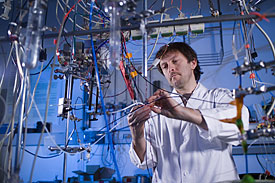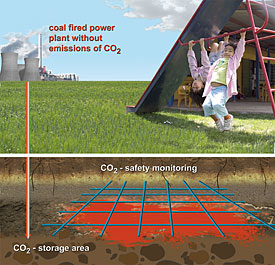Press release from May 7th, 2008
New gas sensors for monitoring carbon dioxide sinks
A world novelty first presented at IFAT 2008
Munich/Halle (Saale). A novel gas sensor system makes it possible to monitor large areas cost-effectively the first time. The patented gas sensor is based on the principle of diffusion, according to which certain gases pass through a membrane faster than others. Using a tube-like sensor it is possible to measure an average gas concentration value over a certain distance without influencing or distorting conditions in the measuring environment. If such sensors are laid in a particular pattern, it is possible to calculate the concentration of a gas over an area. The measuring tube can therefore replace a large number of individual sensors, making it much cheaper than previous methods. The sensor was developed at the Helmholtz Centre for Environmental Research (UFZ) and is being presented for the first time at the 15th International Trade Fair for Water – Sewage – Refuse - Recycling (IFAT), which is taking place from 5 to 9 May in Munich.

Dr. Detlef Lazik, UFZ in the development of the new gas sensor.
Source: André Künzelmann/UFZ

Functional principle of the membranbasierten Gassensors. A potential application of the new gas assensor is the monitoring of carbon dioxide storage from power plants.
UFZ Source: Susan Walter/UFZ
Potential fields of application for the membrane-based gas sensors (‘MeGa’) are environmental remediation and landfill monitoring. But in future the technology could also be used to monitor the underground injection of carbon dioxide, gas pipelines or sewers. The principle can also be used in liquids, so the probe is also useful for monitoring waterbodies (e.g. for observation of hydrogen sulphide formation), including groundwater, and for monitoring boreholes. The slimline construction of the borehole and waterbody probe means that it can be used in gauges. The (permanent) connection to the part above ground allows data capture/evaluation to take place while the probe is submerged. To our knowledge a device with these features has never previously been available anywhere in the world. Another potential field of application is process monitoring in water treatment or in the food industry, e.g. in breweries and dairies.
The researchers are hoping that in future their system can also contribute to more intelligent ventilation of indoor spaces. An excessive level of carbon dioxide leads to fatigue and health problems, while excessive ventilation means a waste of energy. In classrooms, lecture theatres of all kinds and in workplaces there are therefore recommendations for indoor air concentrations of 1000 and 3000 ppm. “Monitoring these indoor air concentrations has failed so far because of a lack of suitable, reasonably priced measuring methods linked to appropriate ventilation technology,” explains Dr Detlef Lazik from the UFZ. “With our membrane-based gas sensors it is for instance possible to have decentralised ventilation using a ventilator that is controlled by a gas sensor. The ventilation is then simply switched on if an adjustable threshold value is exceeded.” The same principle can be used for monitoring dangerous substances in mining, in buildings and facilities or in tunnels.
The Helmholtz Centre for Environmental Research (UFZ) will be represented at IFAT 2008, the specialist trade fair for water, sewage, refuse and recycling, in Munich from 5 to 9 May 2008. Experts at the UFZ stand (Stand 207) in Hall B1 will be providing information about managing contaminated sites and presenting the latest environmental technologies and new products. As well as MeGa, a membrane-based gas sensor for measuring carbon dioxide in waterbodies and in the soil, the UFZ will be displaying Carbo-Iron (a novel material for in situ remediation), RF-Heating (soil remediation through targeted heating) and Compartment Transfer (breaking down hazardous substances using semi-natural wetlands).
For more information, please visit:
IFAT-Ausstellerprogramm des UFZ
IFAT
Halle B1 /Stand-Nr. 207
Links:
http://www.ufz.de/index.php?de=13963
Further information from:
Dr Detlef Lazik
Helmholtz Centre for Environmental Research (UFZ)
Phone +49-345-558-5209
and
Dr. Jens Hagenau
Helmholtz Centre for Environmental Research (UFZ)
Phone +49-345-558-5408
or from Tilo Arnhold (UFZ press office)
Phone +49-341-235-1269
E-mail: presse@ufz.de
Das At the Helmholtz Centre for Environmental Research (UFZ) scientists research the causes and consequences of far-reaching environmental changes. They study water resources, biological diversity, the consequences of climate change and adaptation possibilities, environmental and biotechnologies, bio energy, the behaviour of chemicals in the environment and their effect on health, as well as modelling and social science issues. Their guiding research principle is supporting the sustainable use of natural resources and helping to secure these basic requirements of life over the long term under the influence of global change. The UFZ employs 900 people at its sites in Leipzig, Halle and Magdeburg. It is funded by the German government and by the states of Saxony and Saxony-Anhalt.
Die The Helmholtz Association helps solve major, pressing challenges facing society, science and the economy with top scientific achievements in six research areas: Energy, Earth and Environment, Health, Key Technologies, Structure of Matter, Transport and Space. With 25,700 employees in 15 research centres and an annual budget of around EUR 2.3 billion, the Helmholtz Association is Germany’s largest scientific organisation. Its work follows in the tradition of the great natural scientist Hermann von Helmholtz (1821-1894).
